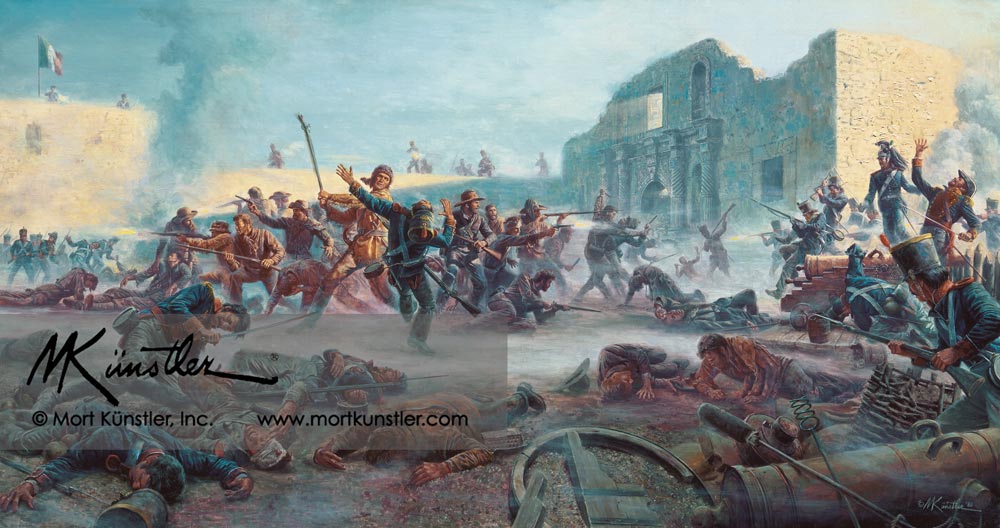The Official Mort Künstler Website
Fall of the Alamo, The – limited edition print
Fall of the Alamo, The – limited edition print
March 6, 1836
Couldn't load pickup availability
Custom framing is available for this print. Please call 800-850-1776 or email info@mortkunstler.com for more information.
Limited Edition Giclée Print on Canvas
Reproduction technique: Giclées are printed with the finest archival pigmented inks on canvas.
Each print is numbered and signed by the artist's daughter, Jane Künstler, and accompanied by a Certificate of Authenticity.
Classic 19” x 36”
Signed & Numbered • Edition Size: 100
Historical Information
All through the 1820s, land-hungry Americans flooded into the rich lands of Texas. Land was to be had cheaply – ten cents an acre – and the Mexican government, whose territory it was, was distant and benign. By 1830, however, Mexican leaders were nervous at the steady influx of Americans. Texan and Mexican hostilities increased during the presidency of adventurer General Santa Anna whose suspension of the Mexican constitution provoked Texans into declaring their independence. Determined to regain Mexico’s lost territory, Santa Anna gathered together a mighty army and advanced northward towards San Antonio in the winter of 1835. By late February 1835, General Santa Anna was laying siege to the old Franciscan mission of the Alamo where a small contingent of 187 Texans—including Colonel William Travis, Jim Bowie and Davy Crockett—had taken refuge. On the morning of March 6th, the Mexicans, under orders from Santa Anna to show no quarter, began their final assault. Hundreds of Mexicans died before the gallant defenders ran out of ammunition. Retreating from room to room, fighting with swords and bayonets, the Texans were massacred to a man; their bodies later stacked against the walls of the Alamo and burnt. “Remember the Alamo” became the battle cry of Texans fighting for independence. That battle was soon won, for on April 21, at San Jacinto, Sam Houston captured Santa Anna himself and all but annihilated his army—at the cost of only sixteen Texans.
Mort Künstler’s Comments
I try to recreate a scene in a dramatic and accurate way to make the viewer feel he is there. Each painting is researched carefully for costume, architecture, weaponry, landscape, weather conditions and time of day. I believe there is no reason why a painting cannot be dramatic and historically accurate. I work first with known facts, such as the architecture, costumes, etc. Then I check the written documents for additional facts. Finally, I consider probability and possibility.
There are thousands of decisions made in each painting. None are taken lightly. The attack on the Alamo began at 4:00 a.m. on March 6, 1836. Sunrise in San Antonio on March 6 is approximately 6:54 a.m. The message of victory to Mexico City was sent at 8:00 a.m. The moment I depict is about ten minutes after sunrise, leaving ample time for survivors to make it to the interior rooms where the final fighting took place.
The heroic posture of Davy Crockett is quite deliberate. I want to show the centers of interest as Crockett and the Shrine so that the painting could be identified instantly as the fall of the Alamo. The most vulnerable section of the fort was the palisade on the south side of the open courtyard in front of the Chapel. The legendary Crockett, along with his small group of Tennesseans, was assigned to defend it.
Archeological information from the Alamo and a painting by Theodore Gentilzdone shortly after the battle give irrefutable evidence that the Shrine had a different appearance at the time of the battle. The present Alamo Shrine has two additional windows and a peaked center on the front wall of the second story. None of this existed at the time of the battle but was added by the U.S. Army in 1847.
On the advice of Mr. Charles Long, Curator Emeritis of the Alamo Long Barrack Museum, I placed the “1824” flag over the Long Barracks and not the “Lone Star” flag flying over the Chapel, the way it is usually shown. Today, the former Church, known as the Shrine of Texas Liberty, remains the oldest standing structure in San Antonio.





